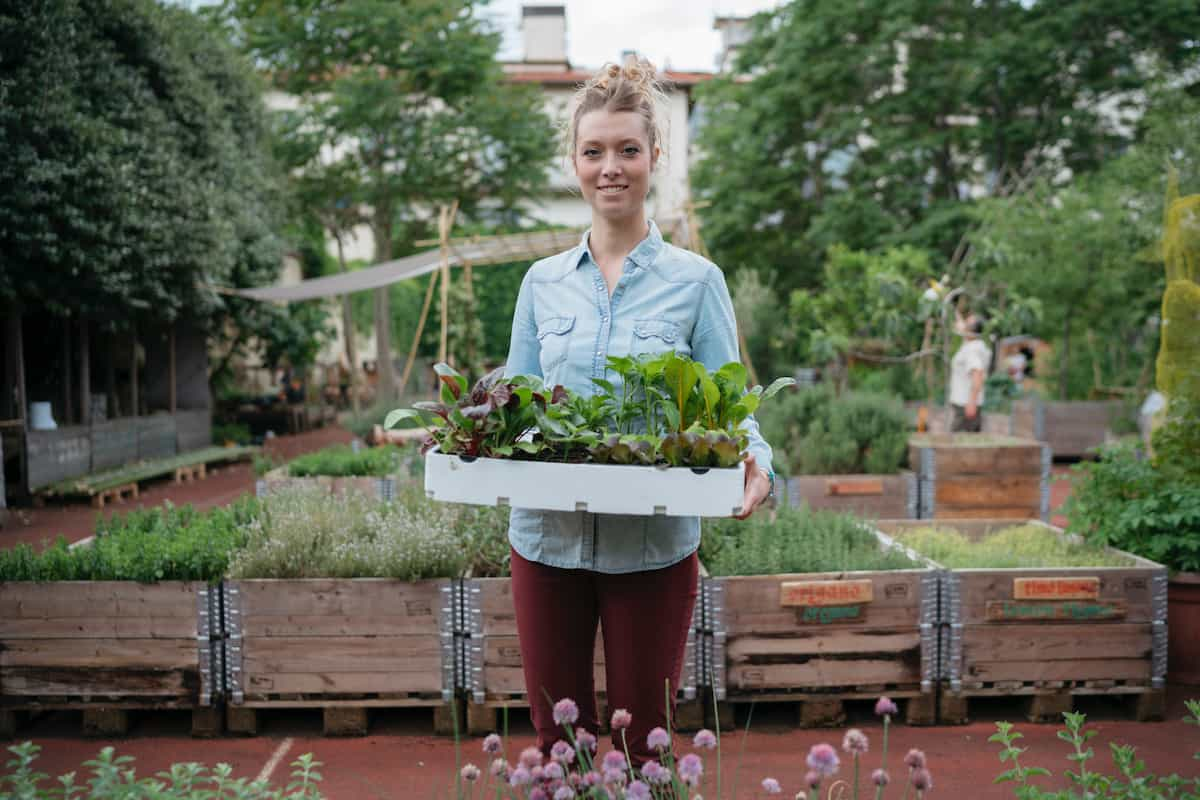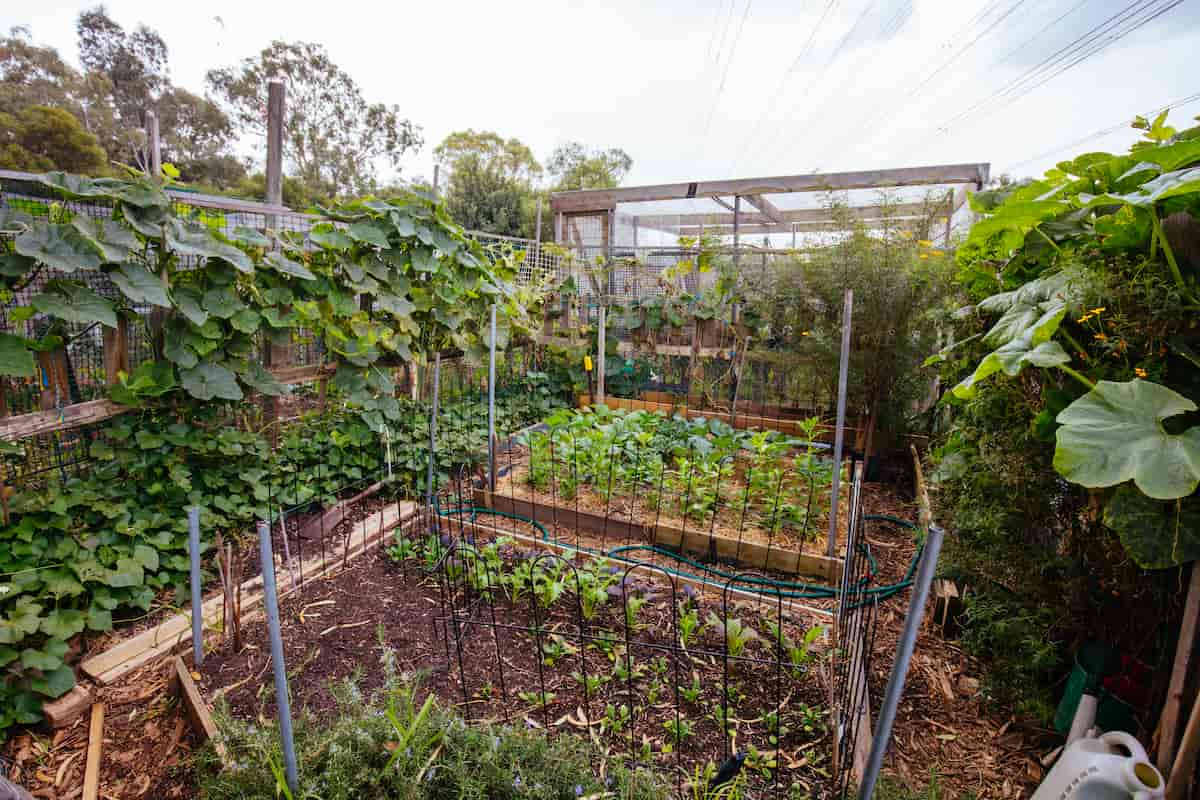Urban gardening has increased in recent years, with more people looking for ways to grow their food in limited spaces. Vegetable growing can give you nutritious meals at home. Below we learn about starting your own urban vegetable garden, including choosing the right location, selecting suitable vegetables, preparing your garden bed, and maintaining your garden for a successful harvest.

How to Start Urban Vegetable Garden at Home
Selecting the Right Location
- Sunlight: Most vegetables require at least six hours of direct sunlight daily. Observe your space throughout the day to identify areas with the most sunlight. South-facing locations typically receive the most sun.
- Accessibility: Choose a location that is easily accessible for regular maintenance, watering, and harvesting. The closer your garden is to your home, the more convenient it will be to care for.
- Drainage: Good drainage is essential for healthy plant growth. Avoid areas with poor drainage or standing water, leading to root rot and other diseases.
- Space: Assess the available space to determine the size and layout of your garden. Even small spaces, such as balconies, patios, or rooftop gardens, can accommodate container or vertical planters.
Selecting Suitable Vegetables
- Climate: Research the vegetables that grow well in your local climate. Consult your region’s planting calendar or seek advice from local gardening clubs or nurseries.
- Space requirements: Some vegetables, such as tomatoes, peppers, and cucumbers, need more space than others. Plan your garden layout based on the space requirements of your chosen vegetables.
- Harvest times: Choose a mix of early, mid-season, and late-harvest vegetables to enjoy fresh produce throughout the growing season.
- Personal preferences: Grow vegetables that you and your family enjoy eating. For added interest, consider experimenting with different varieties, such as heirlooms or unusual types.
Preparing Your Garden Bed
- Raised beds: Raised beds are an excellent option for urban gardens, as they provide good drainage and can be built to fit any space. Fill your raised bed with high-quality garden soil and compost for optimal plant growth.
- Containers: Container gardening allows for greater flexibility, making it an ideal choice for balconies, patios, and rooftops. Choose large enough containers to accommodate the mature size of your plants and have drainage holes to prevent overwatering.
- Vertical gardens: Utilize vertical space by installing trellises, hanging planters, or wall-mounted planters. This method is particularly useful for growing climbing vegetables like beans, peas, and cucumbers.
In case you missed it: Urban Greenhouse Farming: Way to Bring Fresh Produce Closer to Cities

Planting Your Vegetables
- Timing: Plant your vegetables according to their specific planting dates. Consult your region’s planting calendar or seed packets for guidance.
- Spacing: Follow the recommended spacing guidelines for each vegetable to ensure proper air circulation and room for growth. Overcrowding can lead to pest and disease problems.
- Planting depth: Plant seeds or seedlings at the appropriate depth, as indicated on seed packets or plant tags. Planting too deep or too shallow can hinder germination and growth.
- Watering: Thoroughly water your newly planted vegetables to help settle the soil and establish strong root systems. During the periods of germination and early development, be sure to keep the soil wet without allowing it to get saturated.
Maintaining Your Urban Vegetable Garden
- Watering: Water your plants consistently, particularly during hot or dry periods. Containers and raised beds may require more frequent watering due to faster evaporation rates. Be sure to water deeply to encourage strong root growth.
- Fertilizing: Apply an organic fertilizer, such as compost, well-rotted manure, or a slow-release granular fertilizer, according to the specific needs of your vegetables. Regularly supplement with a liquid fertilizer, like seaweed or fish emulsion, to provide additional nutrients throughout the growing season.
- Mulching: Mulch your garden beds with organic materials, such as straw, wood chips, or shredded leaves, to help retain moisture, suppress weeds, and regulate soil temperature.
- Pest and disease control: Regularly inspect your plants for signs of pests or diseases. Use organic or chemical-free methods to control problems, such as introducing beneficial insects, using insecticidal soap, or applying horticultural oil. Remove and dispose of any diseased plant material promptly to prevent the spread of infection.
- Pruning and training: Prune and train your plants to promote healthy growth, improve air circulation, and maximize yields. Stake or cage tall or heavy plants, like tomatoes and peppers, to provide support and prevent breakage.
- Succession planting: To extend your harvest season, practice succession planting by sowing new seeds or transplanting seedlings at regular intervals. This ensures a continuous supply of fresh vegetables throughout the growing season.
Harvesting Your Vegetables
- Timing: Harvest your vegetables when they are at their peak of ripeness for the best flavor and nutritional value. Consult seed packets, plant tags, or gardening resources for guidance on when to harvest each vegetable.
- Picking technique: Use a gentle picking technique to avoid damaging the plants. Use sharp, clean scissors or pruners to cut stems or vines, leaving a small portion of the stem attached to the fruit or vegetable.
- Regular harvesting: Regularly harvest your vegetables to encourage continuous production. Picking fruits and vegetables as they ripen can also help prevent pest and disease problems.
- Storage: Store your harvested vegetables properly to maintain their freshness and quality. Most vegetables can be stored in a cool, dark place, while some require refrigeration.
Crop Rotation and Companion Planting
- Crop rotation: Rotate your crops each year to prevent the buildup of soil-borne diseases and pests. This practice also helps maintain soil fertility by preventing nutrient depletion. Divide your vegetables into groups based on their plant families, and rotate these groups in a regular cycle.
- Companion planting: Plant compatible vegetables to improve nutrient uptake, repel pests, and attract beneficial insects. Some common companion planting combinations include tomatoes with basil, beans with corn, and carrots with onions.
In case you missed it: How to Grow Spinach in Small Spaces: A Guide for Urban Gardeners

Conclusion
Urban vegetable gardening offers many benefits, from providing fresh, nutritious produce to promoting self-sufficiency and sustainability. By carefully selecting your location, vegetables, and garden bed type and diligently maintaining your garden, you can enjoy a bountiful harvest from your urban oasis. With a bit of planning, patience, and effort, you’ll soon discover the joys and rewards of growing your food in your city.
- Feed Your Flock for Less: Top 10 Tips to Save on Chicken Feed
- Ultimate Guide to Ossabaw Island Hog: Breeding, Raising, Diet, and Care
- Hatching Answers: The Top 10 Reasons Your Chickens Aren’t Laying Eggs
- Eggs and Economics: Breaking Down the Cost of Raising Backyard Chickens
- Defend Your Greens: Proven Methods to Keep Iguanas Out of Your Garden
- Ultimate Guide to Cinnamon Queen Chicken: A Comprehensive Guide for Beginners
- Ultimate Guide to California Tan Chicken: Breeding, Raising, Diet, Egg-Production and Care
- Ultimate Guide to Marsh Daisy Chicken: Breeding, Raising, Diet, and Care
- 10 Types of Chicken Farming Businesses You Can Start for Profits